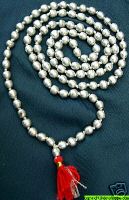 |
 |
The
`Aphorisms on Love' by Vatsyayana contain about one thousand two hundred
and fifty slokas or verses, and are divided into parts, parts into chapters,
and chapters into paragraphs. The whole consists of seven parts, thirty-six
chapters, and sixty-four paragraphs. Hardly anything is known about the
author. His real name is supposed to be Mallinaga or Mrillana, Vatsyayana
being his family name. At the close of the work this is what he writes
about himself:
`After
reading and considering the works of Babhravya and other ancient authors,
and thinking over the meaning of the rules given by them, this treatise
was composed, according to the precepts of the Holy Writ, for the benefit
of the world, by Vatsyayana, while leading the life of a religious student
at Benares, and wholly engaged in the contemplation of the Deity. This
work is not to be used merely as an instrument for satisfying our desires.
A person acquainted with the true principles of this science, who preserves
his Dharma (virtue or religious merit), his Artha (worldly wealth) and
his Kama (pleasure or sensual gratification), and who has regard to the
customs of the people, is sure to obtain the mastery over his senses. In
short, an intelligent and knowing person attending to Dharma and Artha
and also to Kama, without becoming the slave of his passions, will obtain
success in everything that he may do.'
The
Kama Sutra contains a total of 64 sexual positions and depicts positions
as arts. Vatsyayana believed there were eight ways of making love, multiplied
by eight positions within each of these. In the book, they are known as
the 64 Arts. The chapter listing sexual positions is the best-known, and
a translation (different from Burton's) is in wide circulation on the Internet.
This chapter was pirated from the 1980 translation of Indra Sinha and first
appeared on the internet server wiretap.spies in the late eighties. It
is commonly mistaken to be the entirety of the Sutra.
However, only about 20 percent of the book is devoted to sexual positions. The remainder gives guidance on how to be a good citizen and insights into men and women in relationships. The Kama Sutra describes making love as "divine union". Vatsyayana believed that sex itself was not wrong, but doing it frivolously was sinful. The Kama Sutra has helped people enjoy the art of sex at a deeper level and can be considered a technical guide to sexual enjoyment, as well as providing insight into the sexual mores and practices of India in those times
Press
Information
LiveIndia.Com

A complete translation of the original work now
follows. It has been prepared in complete accordance with the text of the
manuscript, and is given, without further comments.

Pattaya
Beach &
Bangkok

Temples of Love |
 |
Free Listing Female models |

Pattaya Beach & Bangkok |

Las Vegas & Casino |
 |
 |

PARAD
MALA more....
Wearing of parad
mala /bead( goli) helps in controlling various diseases like High Blood
Pressure, Asthma and increase the Sex Power.Parad has special significance
in Ayurveda too.
|
|
|
|
|
|
 |
 |
|
All rights reserved. No part of this publication and other sites of under liveindia.com may be transmitted or reproduced in any form or by any means without prior permission from the publisher Live India Internet Services or Rajesh Chopra, L.C.Premium Cables, 1826, Amar Nath 2nd Building, Bhagirath Palace Delhi - 110006, India. Liveindia.com or Mr.Rajesh Chopra is not responsible for any wrong information under this site, |